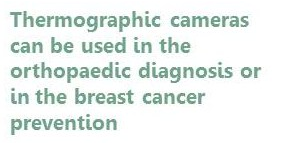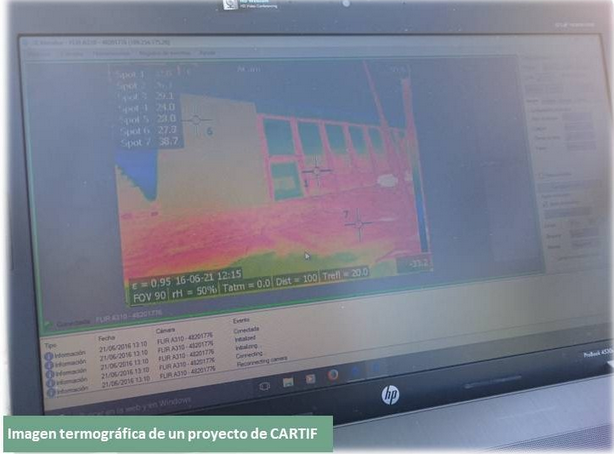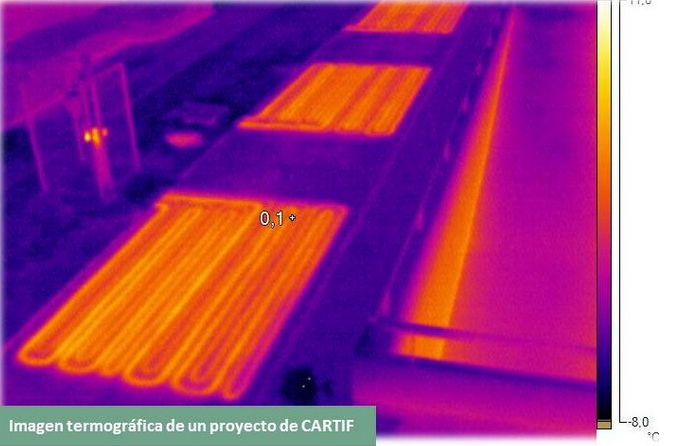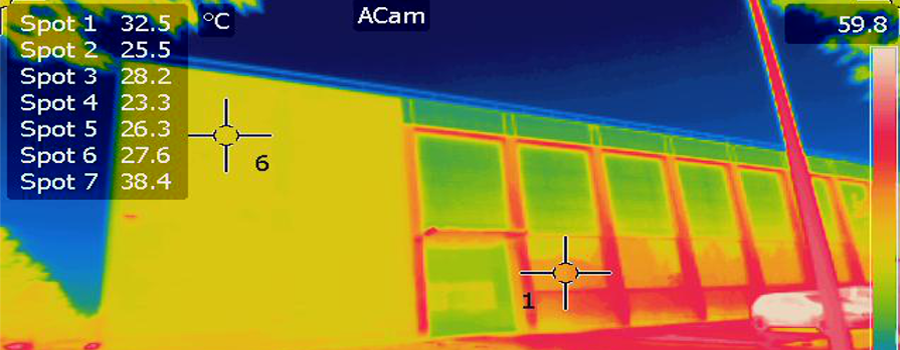Everybody knows what a thermographic camera is. Movies as “Predator”, the formula 1 broadcast, etc. have helped people to know this technology. CARTIF has been using it, during last years, in construction and infrastructure inspection.
My intention is not to tell you again, what everyone already knows, but talking about some myths and misconceptions that people have regarding its use.

Thermography is based on that any object with a temperature above zero kelvins emits infrared radiation, which is not visible to the human eye. This radiation depends on the object temperature, thus knowing the said radiation; it is possible to obtain the temperature.
A thermographic camera not only acquires this radiation (emitted radiation), but also the reflected and the transmitted radiation. Moreover, there are other parameters beyond the object temperature involved, so the temperature determination is not easy.
Thermographic camera have software which is able to calculate the object temperature in a transparent way to the user. If the operator relies too much on the said software and he doesn’t know well what he is doing, then issues might appear. A non-experienced operator may make some mistakes. In this post, we would like to clarify some misconceptions about thermography that general public has:
1. Thermal imaging cameras can see below the surface of a target. FALSE.
The camera only sees the surface of a target and calculates the temperature

2. All types of materials can be easily measured with thermal imaging cameras. FALSE.
The temperature information is given in the emitted radiation, but the imager also “sees” the reflected and transmitted components. Most materials are opaque to infrared, so we can usually ignore the transmitted energy. However, many materials (with low emissivity) reflect infrared radiation, thus these materials are difficult to be measured using a thermal camera.
3. Thermal imaging cameras should never be used in the daylight. FALSE.
Infrared thermal imaging cameras do not detect visible light. They are only sensitive to infrared radiation, but it is easier to control reflected radiation at night, so it is advisable doing thermal inspection during that period of time.
4. Knowing the emissivity of the inspected object is not necessary. FALSE.
This is the most important factor the camera must know to correctly calculate the temperature.
5. This technology is really expensive. FALSE.
Nowadays, with the technological progress there are thermal cameras at competitive prices. Even, FLIR commercializes an accessory which transforms your mobile phone into a thermal camera.
Finally, I would to talk about some innovative thermography applications:
1. Infrared vision in a contact lens
Engineers from the Michigan University are developing contact lens with infrared vision, using graphene.
2. Detection of tiny motors in pro cyclist bikes
Femke Van den Driessche, one of the favorites at the Under-23 Women’s World Championships in Belgium, was found to be racing with a mechanical motor this past January by the UCI. This is known as the first mechanical doping in cycling history.
3. Orthopaedic diagnosis
Researchers at UPM confirm the usefulness of infrared thermography (IRT) for detection and early diagnosis of orthopaedic injuries.

A research group of Thermography Unit from the Faculty of Sciences for Physical Activity and Sport (INEF) at Universidad Politécnica de Madrid (UPM) in collaboration with CEMTRO has carried out a study to establish the capacity of infrared thermography (IRT) to discriminate injuries and to evaluate its applicability in emergency trauma scenarios.
Results show that this technology is a great support tool to correctly identify the presence or absence of injuries in a particular body part.
4. Pest control
Some tests have concluded that it is possible to use thermography in order to pest detection, due to the correlation between the presence of insects and humidity.
Furthermore, some anomalies detected on thermal images might be caused by some insects such as termites.
5. Breast cancer prevention using thermography
This method is based on detect temperature changes in thermal images. Cancer creates blood vessels when it starts to develop. This process, which is known as angiogenesis, produces heat, so a thermal camera could detect this heat long before cancer can develop.
- Why do we like some landscapes more than others? - 22 July 2022
- Aerial Images Treatment - 7 June 2017
- 3D digitalization of infrastructures: Guadarrama tunnels - 14 October 2016

Overall, I thoroughly enjoyed your article and found it highly informative.